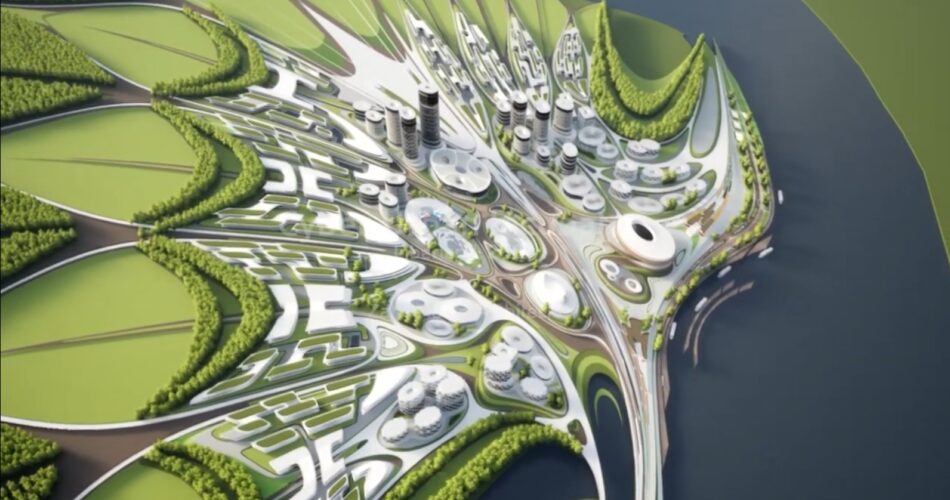A city wedged between Serbia and Croatia
First established in 2015, thanks to the metaverse, Liberland, will be the first nation to be created and populated in the virtual world before being realized in the real world.
According to this article, the renowned architectural firm Zaha Hadid Architects has been developing a concept for a virtual city that will house the nation’s expanding population.
Liberland has 7,000 accepted residents despite not being an officially recognized nation, and another 700,000 citizenship applications are still being reviewed. The 7 km2 region, wedged between Serbia and Croatia, is disputed terrain and is claimed by neither nation, and it is larger than Monaco or Vatican City.

Since being founded by former Czech MP Vit Jedlička, and his partner Jana Markovicova, the micronation’s president, Liberland has progressively improved its standing abroad. Libertarian Jedlička worked to establish what he saw as a brand-new civilization that was unencumbered by the conventions of the past prior to 2015. He made great attempts, but he ran into too many obstacles.
“At that point, I realized it might be easier to start a new country than change an existing one”, he said.
The pair immediately turned to Google to look for land that may be suitable for their needs once this novel and the fascinating idea had taken hold. As a result, a small piece of abandoned land was discovered on the Danube’s west bank, and the Free Republic of Liberland was established. Since the dissolution of the Socialist Federal Republic of Yugoslavia, there has been a border dispute between Croatia and Serbia due to their competing claims to various Danube-side areas.
However, the region Jedlička discovered on the western bank of the river had not been claimed by either Croatia or Serbia or any other nation, therefore it was in a state of terra nullius, or a no man’s land. That is, until April 13, 2015, when the founders of Liberland, led by Jedlička, the current president of the interim government, formally proclaimed the territory their own.
“We are building a country that can serve as a good example for other countries. The biggest improvement is that, in Liberland, taxes are voluntary, and people are rewarded when they pay them”, Jedlička said.
“We founded Liberland on April 13, 2015, to celebrate the birthday of Thomas Jefferson. We wanted to invoke the spirit of the American Revolution. We also want to combine the best elements of the American republic, Swiss democracy, and the meritocracy of Singapore. We want to put our system on the blockchain so that the government will work in a modern and transparent way”.
Liberland grounds its claim to nationality on four fundamental principles of international law. The ability to engage in international relations with other states comes last. The first is a population, followed by a defined area, a government, and then a population.
“The first day we had 2,000 applications for citizenship, the second 10,000 and by the third, we had 200,000. This alone shows that there is a demand for what we are doing,” Jedlička said.
Liberland is making a place for its tens of thousands of residents to meet without having to travel to that little, now-empty piece of land by collaborating with Zaha Hadid Architects to develop a metaverse.
In fact, since tourists are not then at risk of being detained by Croatian police, it may be a safer option for its potential citizens. The principal architect of Zaha Hadid and a longtime Liberland advocate, Patrik Schumacher oversaw earlier architectural competitions to develop a concept for a real-world Liberland.
He is offering a different and faster approach for Liberland people to enter the micronation by gazing at a metaverse. The inventor of parametricism, a term first used in 2008 that essentially changed how architecture interacted with computer technology and algorithms, is a legend in the field.
His description of the future of the virtual world, “12 Theses on the Advent of the Metaverse“, was recently released. According to Schumacher’s main argument, the metaverse will enable lifelike telepresence, co-location synergy, explorative browsing, immersiveness, collective experiences, and so on.
All websites will spatialize, all organizations will enter the metaverse, and all physical venues will be supplemented or replaced by functionally identical virtual venues, ensuring that everyone takes advantage of this opportunity. His second claim is that there is only one reality in the metaverse.
“The metaverse is neither a game nor fiction. Virtual reality in the metaverse will be no less real than the physical reality in our cities”, Schumacher wrote.
“Physically and virtually mediated social communicative interactions are equally significant and together form an undivided continuous social reality. There will be both competition and cooperation within and across these realms”.
“In the coming age of VR-empowered cyberspace, it will be architects and no longer graphic designers who will design the coming 3D immersive internet: the metaverse”, Schumacher wrote.
“This expansion of architecture’s remit will further distill the discipline’s essence and core competency, namely the spatio-visual ordering of communicative interaction, upgraded via investment into the subdisciplines of spatiology, phenomenology, semiology, and dramaturgy”.
In many ways, if we are to build cities that make sense rather than just look nice, it makes sense to finally bring architects into the metaverse.
“We focus much energy on creating physical environments for social interaction and productivity, and we are now entering the realm of UX design for complex real-time multi-user interaction in Virtual Reality platforms. Architects understand how to connect 3D space with social networking”.
The metaverse will have a big impact on how we will experience the Internet. The trend will be to have a parallel digital world where opportunities existing in the real world can be reproduced or multiplied. However, there is a risk of giving the metaverse more importance than the real world with the risk of being captured by a virtual environment to such an extent that we can no longer prefer reality.
